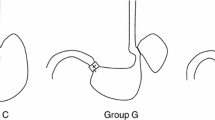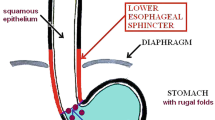Abstract
Background: Although a variety of antireflux procedures and medications are used to treat gastroesophageal reflux disease (GERD), reliable large-animal models of GERD that can be used to objectively compare the efficacy of these treatments are lacking. Methods: Esophageal manometry and 24-h gastroesophageal pH monitoring with event data were performed in 18 mongrel dogs with a cervical esophagopexy. We then calculated a modified DeMeester score: The Duke Canine reflux score (DCR). Thereafter, the animals underwent a 4-cm anterior distal esophageal myotomy, incision of the left diaphragmatic crus, and intrathoracic gastric cardiopexy. Postoperative 24-h pH and manometry were obtained 2 weeks later. Results: The postoperative 24-h pH results showed a significant increase in the mean DCR score (5.9 ± 4.5 vs 84.9 ± 56.1, p < 0.0002), and manometry indicated a significant decrease in mean lower esophageal sphincter (LES) pressure (7.1 ± 2.9 vs 3.2 ± 2.5 mmHg, p < 0.0001). Conclusion: This technique reliably creates a canine model of GERD.
Similar content being viewed by others
Author information
Authors and Affiliations
Rights and permissions
About this article
Cite this article
McMahon, R., Ali, A., Chekan, E. et al. A canine model of gastroesophageal reflux disease (GERD). Surg Endosc 16, 67–74 (2002). https://doi.org/10.1007/s004640080153
Received:
Accepted:
Published:
Issue Date:
DOI: https://doi.org/10.1007/s004640080153




